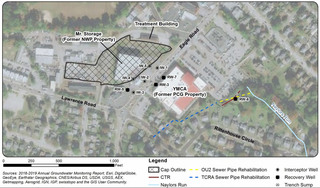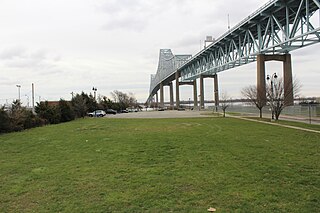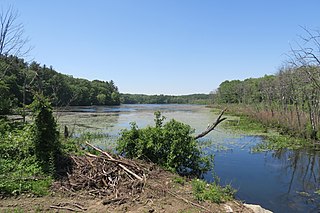
Havertown Superfund is a 13-acre polluted groundwater site in Havertown, Pennsylvania contaminated by the dumping of industrial waste by National Wood Preservers from 1947 to 1991. The state first became aware of the pollution in 1962 and initiated legal action against the owners in 1973 to force them to cleanup the site. The Environmental Protection Agency (EPA) ranked the site the eighth worst cleanup project in the United States. The site was added to the National Priorities List in 1983 and designated as a Superfund cleanup site in the early 1990s. Remediation and monitoring efforts are ongoing and the EPA transferred control of the site to the Pennsylvania Department of Environmental Protection in 2013.
Diamond Alkali Company was an American chemical company incorporated in 1910 in West Virginia by a group of glass industry businessmen from Pittsburgh. The company soon established a large chemical plant at Fairport Harbor, Ohio, which would operate for over sixty years. In 1947, the headquarters of the company was moved from Pittsburgh to Cleveland. Later the company established a plant in Redwood City, California, that produced ion-exchange resins. In 1967, Diamond Alkali and Shamrock Oil and Gas merged to form the Diamond Shamrock Corporation. Diamond Shamrock would go on to merge with Ultramar Corporation, and the combined company, Ultramar Diamond Shamrock Corporation, would in turn be acquired by Valero Energy Corporation in 2001.
In 1990, the Allied Paper, Inc./Portage Creek/Kalamazoo River in southwestern Michigan was declared by the Environmental Protection Agency (EPA) to be a Superfund site – in other words, an abandoned industrial site containing significant amounts of toxic waste. The EPA and companies responsible for the waste in this area, which includes a three-mile section of Portage Creek as well as part of the Kalamazoo River, into which it flows, are currently involved in an effort to reduce the amount of toxic waste at the site, which is contaminated by PCBs from paper mills and other factories.

Wade Dump was a rubber recycling facility and illegal industrial waste storage and disposal facility in Chester, Pennsylvania. It was located at 1 Flower Street on the western bank of the Delaware River just north of the Commodore Barry Bridge.
The Omega Chemical Corporation was a refrigerant and solvent recycling company that operated from 1976 to 1991 in Whittier, California. Due to improper waste handling and removal, the soil and groundwater beneath the property became contaminated and the area is now referred to as the Omega Chemical Superfund Site. Cleanup of the site began in 1995 with the removal of hazardous waste receptacles and a multimillion-dollar soil vaporization detoxifying system.
The Alabama Plating Company Superfund site is a former industrial site in Vincent, Alabama. The site covers 6 acres and was used by the Alabama Plating Company as an electroplating facility between 1956-1986. The facility caused contamination of the ground water with hazardous waste containing heavy metals. After assessment by the United States Environmental Protection Agency (EPA) it was added to the National Priorities List in September 2012 for remedial action. The site cleanup is directed by the federal Superfund program.

The Koppers Co., Inc. (KCI) Superfund Site is one of three Superfund sites in Oroville, California, along with Louisiana Pacific Sawmill and Western Pacific Railyard. The KCI Superfund Site is a 200-acre site which served as a wood treatment plant for 50 years. Wood was treated with many chemicals to prevent wood deterioration. The accumulation of these chemicals from spills, fires, and uses has caused this site to be contaminated with the hazardous waste material. Due to soil and groundwater contamination, the site was placed on the National Priorities List in 1984 for remedial action plans to clean up the site to protect surrounding residential areas concerning environmental and human health risks.

Hocomonco Pond is a recreational pond located in Westborough, Massachusetts near Route 9. Also called Hobomoc Pond, it was named for Hobomok, a Wamesit Indian evil spirit. The pond and adjacent land are a Superfund site.
The Federal Creosote Superfund site is a 50-acre (20 ha) property located in Manville, New Jersey. It was used as a wood treatment facility. Starting in 1919, the site was contaminated with creosote. Creosotes are a category of carbonaceous chemicals formed by the distillation of various tars and by pyrolysis of plant-derived material, such as wood or fossil fuel. They are typically used as preservatives or antiseptics. It took the EPA about 18 years to cleanup the site.
The Diamond Head Oil Refinery is a former oil reprocessing facility located in Kearny, New Jersey, United States, that was designated as a Superfund site by the Environmental Protection Agency (EPA). It opened up in 1946, but then stopped production in 1979 and has been inactive since then. The refinery was shut down in 1980 and the EPA designated it as a Superfund site in 1991 due to the discovery of toxic chemicals in the soil and the surface water. This created a dangerous work environment for the workers at the facility. The EPA proposed a clean up plan for the site, but it has yet to take effect. So far, the Diamond Head site is still in the process of being cleaned up. Although cleanup plans were discussed and finalized, the future of the Diamond Head Oil Refinery and its cleanup state is unknown.
Bog Creek Farm, located in Howell Township, New Jersey, is a designated Environmental Protection Agency (EPA) Superfund site. Lying on 12 acres of land, Bog Creek Farm is home to several hazardous and life-threatening contamination beginning in 1973 and continuing for a year. Over a decade later, actions began to take place to clean and restore the contaminated soil and water. Bog Creek Farm is situated near several other farms that house horses, growing crops and flowers, and livestock. Less than a mile down the road lies Allaire State Park, a park used by golfers, hunters, and fisherman.
The K & L Avenue Landfill, also known by the spelling K&L Avenue Landfill, is an 87-acre (35-hectare) Superfund site accessed from KL Avenue in Oshtemo Township, Kalamazoo County, Michigan. It is one of six Superfund sites in the Kalamazoo River watershed.
Barrels, Inc. is a Superfund site located in Lansing, Michigan. The site's surface soils and groundwater have been contaminated from a storage tank and drum reclamation processes. Today the area is fenced in while cleanup options are being discussed in order to limit direct contact with the potential risks. In 1961, Barrels Inc. began working on the site, and continued until the owner abandoned the site in 1980.
Forest Waste Products is a 120-acre (49-hectare) Superfund site in Forest Township northwest of Otisville, Michigan.
Thermo-Chem, Inc., also referred to as Thermo-Chem, is a 50-acre Superfund site located in Egelston Township near Muskegon, Michigan.
The G&H Industrial Landfill is a Superfund site located in Shelby Charter Township near Utica, Michigan, United States. The 60-acre (24-hectare) landfill, with about 10 to 20 acres of adjacent property, operated as a waste oil recovery facility from 1955 to 1967. From 1955 to 1974 the site was used as an industrial and municipal landfill. Contaminated soil, surface water, and groundwater with hazardous chemicals have been left behind as a result of the disposal of waste solvents, waste oil and paint sludge. Operation and maintenance activities are ongoing following the cleanup.
The Garfield Groundwater Contamination site is a Superfund site located in Garfield, New Jersey. The site was formally occupied by E.C Electroplating, an electroplating company that used chromic acid solution in their products. In 1983, a tank at the E.C Electroplating property malfunctioned and spilled chromic acid into the groundwater underneath the property that subsequently spread to the surrounding area. The contamination presented a health risk to Garfield residents in the area due to exposure to hexavalent chromium, a toxic form of chromium. The site was designated a Superfund site in 2011. Cleanup of the site is ongoing as of 2022.

The Ott/Story/Cordova Chemical Co. is a 20-acre superfund site that is located in Dalton township in the US State of Michigan.
The Laboratory for Energy-Related Health Research Superfund Site encompasses a 25-acre area, including a former research facility that studied the impact of radiation on beagle dogs, and its adjacent landfill, at the University of California, Davis (UCD). University researchers began studying the possible effects of radiation from nuclear fallout in the 1950s, under an agreement with the unit of the United States Department of Defense that had overseen the Manhattan Project. As a result, the site became contaminated with toxic chemicals and dangerous metals such as strontium-90 and hexavalent chromium.

The Muskegon Chemical Company is a 19.6 acre Superfund site located in Muskegon County, Michigan.






